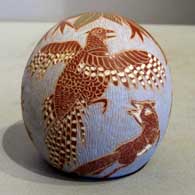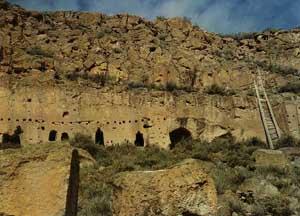
Camilio Sunflower Tafoya
1902-1995
Santa Clara
Camilio Tafoya was born in 1902 to Geronimo and Sarafina Tafoya of Santa Clara Pueblo. Like his sisters, Margaret Tafoya and Christina Naranjo, he grew up watching and helping his mother make pottery. His father, a wood carver, taught him to carve and Camilio adapted that learning to the carving of pottery. He learned to make his clay coils thicker and allow the pots to dry harder before beginning to carve them. That solved the problem of carving too deeply and ruining a pot by carving through it. Using his method he learned to make very large carved jars.
Among his favorite designs to carve were the avanyu (water serpent), birds, flowers, bear paws, and ancient Mimbres and rock art designs he found while hiking around in the hills and mountains surrounding Santa Clara. Joseph, Camilio's son, remembered his father taking him into the mountains and hiking around. Joseph was impressed by the petroglyphs they often came across. Camilio was able to translate the meanings of many of the designs so that Joseph could understand what the designs symbolized. Variations of those carved designs reappeared many times over the years in the work of Camilio and later in Joseph's work. During those walks they also found many old pottery shards, some painted, some incised, some carved, some corrugated and all ancient. That's where the great storehouse of Santa Clara designs is kept.
Camilio was one of the first men to become known as a potter in the pueblo. Many men helped their wives with different aspects of the process, like digging and processing the clay, scraping/sanding pots, gathering firewood and manure, firing the pots, etc., but Camilio did the whole process from end to end. His wife, Agapita (Silva) (1904-1959), was an accomplished potter when they married and they worked together for many years. Camilio and Agapita taught their son, Joseph Lonewolf, and daughters Grace Medicine Flower and Lucy Year Flower how to make pottery.
In the 1960s, after his wife passed, Camilio stopped making his large, carved pots and his famous sculptural horses. Instead, he, Joseph and Grace began developing the fine art of meticulously incising pottery now known as sgraffito. In that method, designs are scratched into the hard-dried surface of a pot before (or after) firing. Simple mistakes can ruin a pot. The amount of time and degree of meticulous work involved have made for increased prices for sgraffito-decorated pots.
In late 1968 Camilio began working closely with Grace, making many highly polished black and red seedpots decorated with intricate sgraffito work. In 1972 he went to work at Joseph's house and was busy making exceptional sgraffito art there almost until the day he died.
In 1985, along with his sister Margaret Tafoya and 42 other Santa Clara potters, Camilio participated in a show at the Sid Deusch Gallery in New York City. He also participated in several gallery shows with his son Joseph in Sacramento and Santa Monica, California and in Santa Fe, New Mexico.
Camilio was well-known for having a great sense of humor. One summer in the early 1990s Joseph was preparing for a show at Andrea Fisher Fine Pottery in Santa Fe. Andrea says Camilio came in to see what was happening, said hello to everyone, sat down and joined in the conversation. Someone asked if he had new boots on (because Camilio always wore fancy cowboy boots). He looked down and said, "No, but I have to keep them clean because I can't take them off and put them on the porch at night. The grasshoppers at Santa Clara are so bad this summer I'm afraid my boots would get eaten."
Camilio passed on in 1995.
100 West San Francisco Street, Santa Fe, New Mexico 87501
(505) 986-1234 - www.andreafisherpottery.com - All Rights Reserved

Santa Clara Pueblo

Ruins at Puye Cliffs, Santa Clara Pueblo
Santa Clara Pueblo straddles the Rio Grande about 25 miles north of Santa Fe. Of all the pueblos, Santa Clara has the largest number of potters.
The ancestral roots of the Santa Clara people have been traced to ancient pueblos in the Mesa Verde region in southwestern Colorado. When that area began to get dry between about 1100 and 1300 CE, some of the people migrated eastward, then south into the Chama River Valley where they constructed several pueblos over the years. One was Poshuouinge, built about 3 miles south of what is now Abiquiu on the edge of the Jemez foothills above the Chama River. Eventually reaching two and three stories high, and with up to 700 rooms on the ground floor, Poshuouinge was occupied from about 1375 CE to about 1475. Drought then again forced the people to move, some of them going to the area of Puye (on the eastern slopes of the Pajarito Plateau of the Jemez Mountains) and others downstream to Ohkay Owingeh (San Juan Pueblo, along the Rio Grande). Beginning around 1580 CE, drought forced the residents of the Puye area to relocate closer to the Rio Grande and they founded what we now know as Santa Clara Pueblo on the west bank of the river, with San Juan Pueblo to the north and San Ildefonso Pueblo to the south.
In 1598 the seat of Spanish government was established at Yunque, near San Juan Pueblo. The Spanish proceeded to antagonize the Puebloans so badly that that government was moved to Santa Fe in 1610, for their own safety.
Spanish colonists brought the first missionaries to Santa Clara in 1598. Among the many things they forced on the people, those missionaries forced the construction of the first mission church around 1622. However, like the other pueblos, the Santa Clarans chafed under the weight of Spanish rule. As a result, they were in the forefront of the Pueblo Revolt of 1680. One Santa Clara resident, a mixed black and Tewa man named Domingo Naranjo, was one of the rebellion's ringleaders. However, the pueblo unity that allowed them to chase the Spanish out fell apart shortly after their success, especially after Popé died.
When Don Diego de Vargas came back to the area in 1694, he found most of the Santa Clarans on top of nearby Black Mesa (with the people of San Ildefonso). A six-month siege didn't subdue them so finally, the two sides negotiated a treaty and the people returned to their pueblos. However, successive invasions and occupations by northern Europeans took their toll on all the tribes over the next 250 years. Then the swine flu pandemic in 1918 almost wiped them out.
Today, Santa Clara Pueblo is home to as many as 2,600 people and they comprise probably the largest per capita number of artists of any North American tribe (estimates of the number of potters run as high as 1-in-4 residents).
Today's pottery from Santa Clara is typically either black or red. It is usually highly polished and designs might be deeply carved or etched ("sgraffito") into the pot's surface. The water serpent, (avanyu), is a very common traditional design motif on Santa Clara pottery. Another motif comes from the legend that a bear helped the people find water during a drought. The bear paw has appeared on much of their pottery ever since.
Santa Clara has received a lot of distinction because of the evolving artistry the potters have brought to their craft. Not only did this pueblo produce excellent black and redware, several notable innovations helped move pottery from the realm of utilitarian vessels into the domain of art. Different styles of polychrome redware emerged in the 1920s-1930s. In the early 1960s experiments with stone inlay, incising and double firing began. Modern potters have also extended the tradition with unusual shapes, slips and designs, illustrating what one Santa Clara potter said: "At Santa Clara, being non-traditional is the tradition." (This refers strictly to artistic expression; the method of creating pottery remains traditional).
Santa Clara Pueblo is home to a number of famous pottery families: Tafoya, Baca, Gutierrez, Naranjo, Suazo, Chavarria, Garcia, Vigil, and Tapia - to name a few.
100 West San Francisco Street, Santa Fe, New Mexico 87501
(505) 986-1234 - www.andreafisherpottery.com - All Rights Reserved


